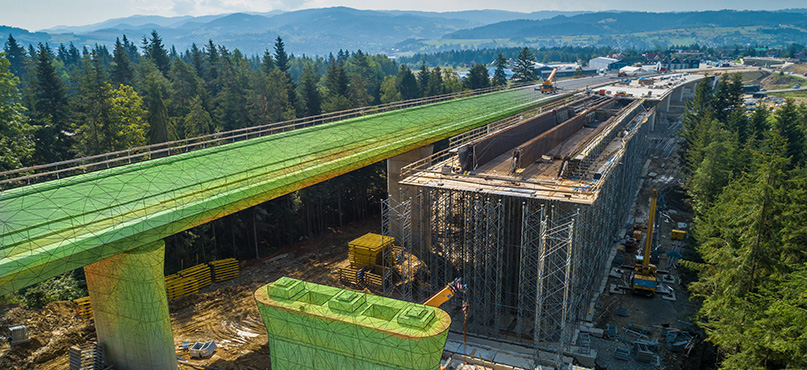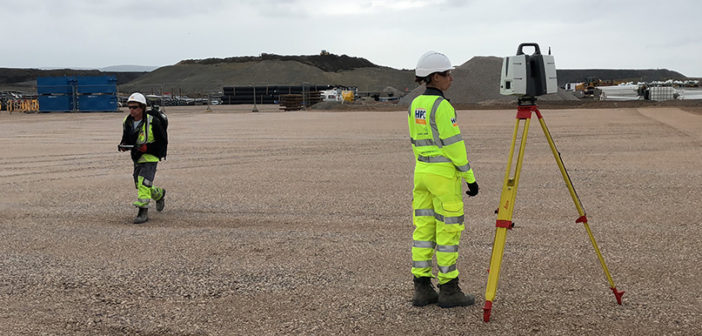Reality capture technology is increasingly being put to work in the construction industry. But when it comes to heavy construction – which includes paving, excavating and machinery control, as well as building highways, bridges, tunnels and dams – its capabilities are only just being realised, especially in terms of helping to drive sustainability.
The use of UAVs or flying laser scanners, to capture large areas from the air, is already an established process in heavy construction, along with mobile mapping systems for road inspection and highway maintenance. However, these are only two methods of reality capture that can be utilised to increase efficiency and safety in the industry.
Here, we look at the benefits of bringing data together from multiple sensors using seamless workflow software for better working methods and discover what the future holds for the heavy construction industry.
 Delivering completeness, reducing time and enhancing visualisation
Delivering completeness, reducing time and enhancing visualisation
When it comes to building roads, bridges and tunnels, the potential to save time, increase safety and simplify workflows is vast. Such projects require survey staff to frequently check work against a design because important infrastructure must be built correctly and safely. If not, the results could be disastrous and reality capture provides confidence to ensure this doesn’t happen.
Reality capture technology offers two main advantages when it comes to heavy construction. The first is completeness, which is the accuracy of capturing complex sites with many different activities going on. On complex active construction sites, measurements and data points can sometimes be missed, but all of these are created into dense point clouds with reality capture. In addition, the ongoing state of the sites can be captured over periods in their development, monitoring changes over the project lifecycle as and when they happen.
The second advantage is capture speed combined with personnel safety. The speed at which reality capture solutions can be put to work to gather data means the time people are working in what can be hazardous conditions is reduced, therefore exposing survey teams to less danger, resulting in enhanced safety.
Reality capture also lends itself well to enhancing the visualisation of heavy construction projects. This process starts with the point cloud data, which can be transferred into a 3D mesh model. The smaller file size of the mesh model allows for efficient collaboration, enabling multiple people to look at the same thing in a realistic setting at the same time. This information is then available to look back on whenever required.
The data can then be turned into a CAD model, which is a more detailed computerised model of the item. Finally, a semantic model can be created. The point cloud gives visual context to the scene and provides simulations that would otherwise be both expensive and near-on impossible to produce. This is what we call a digital twin.
 Providing a holistic solution to heavy construction projects
Providing a holistic solution to heavy construction projects
Reality capture is already being used in the heavy construction industry. For example, FAM Construction (Ferrovial – Allan Myers) collects site information on roadway projects using the Leica RTC360 3D Laser Scanner. This allows the team to monitor retaining walls for minute movement, check the verticality of H-piles, and model steel passes. There could be hundreds of beams per mile and each one needs to be checked for structural integrity. Instead of checking each beam’s elevation and verticality against design one measurement at a time, the RTC360 checks hundreds of H-piles in minutes.
The solution allows the team at FAM Construction to carry out imperative work, including bridge deck work for new and expanded bridges during the build to ensure design tolerances are met; and check for any structural damage of existing bridges to repair. Reality capture enables them to share this crucial data with their Construction Technical Office over the internet using Leica TruView Digital Reality Viewer – an easy-to-operate platform for sharing point cloud data.
Reality capture technology is not only used by experts. It can also be used more generally, owing to the high level of automation it additionally offers. For example, the Leica BLK ARC can be leveraged on robotics such as Boston Dynamic’s Agile Mobile Robot, Spot®, which autonomously carries devices and can be used in more remote, hazardous environments. Then there’s the Leica Pegasus:Backpack, a wearable mobile mapping solution that makes capturing reality so easy for indoor and outdoor mapping – users simply put it on their back, start walking and get the full view of their surroundings in real-time on a tablet device.
An autonomous and sustainable future for heavy construction
Heavy construction is moving towards more autonomy, in parallel with the construction industry as a whole. We will see more autonomous, connected sites and Smart Digital Realities – a convergence of the physical and digital world to allow real-time access to physical world data.
Reality capture technology is empowering this and, as a result, building a more sustainable future for what has been a largely unsustainable industry in the past. Enabling teams to be on site less, cut down on emissions and leverage connected technologies will transform not just the heavy construction industry but our future. We can’t wait to see what’s in store.
 Andrea Biasion
Andrea Biasion
Product Manager
Reality Capture Division
Please visit our website to learn more about Hexagon’s Heavy Construction solutions.














